Llanwenog is a parish situated on the A475, about five miles from Lampeter, and two miles northwest of Llanybydder. The men of the parish who fell during both world wars are commemorated on the war memorial at Drefach, although Llanwenog has its own war memorials, the main ones inside St Gwenog’s Church, and another inside the old school. The memorials inside the church take the form of bench ends on the church pews, and were carved from oak by Joseph Reubens of Bruges, a Belgian refugee, aided by Herbert Davies-Evans, who had served as Captain with the Scots Guards, and as a Lord Lieutenant of Cardiganshire from 1889 until 1924. Herbert’s wife Mary had designed these bench ends, which serve as the memorials to the fallen of the Great War. This page commemorates the men on the memorials inside St. Gwynog’s Church.
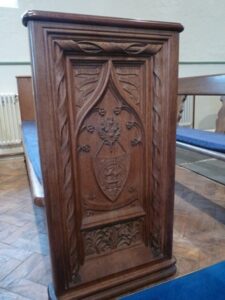
The Great War, 1914-1918
Charles Edward Cheverton, Guardsman, 2034, Welsh Guards. Charles was born on 28 September 1896, the son of William Henry and Alice Cheverton, of Lax Lodge, Llanwenog. Charles’ father worked as Chauffeur to Colonel H. Davies-Evans, of Highmead, Llanybydder. Charles was educated at Llanwenog School, and enlisted at Lampeter into the 1st Battalion, Welsh Guards. The Welsh Guards had been raised by Royal Warrant on 26 February 1915, and moved to France on 18 August 1915 to join the 3rd Guards Brigade, Guards Division. Charles possibly joined the battalion after it suffered heavy casualties during the Battle of Loos, arriving as a reinforcement in time to take part in the Battle of the Somme, which was launched on 1 July 1916. In late July 1916 the Division moved to the Somme, where they fought at the Battle of Flers-Courcelette, and then at the Battle of Morval, capturing Lesboeufs Village. Charles was killed when his battalion were being relieved from the line at Combles on 24 September 1916. He was 23 years old, and is commemorated on the Thiepval Memorial, France.
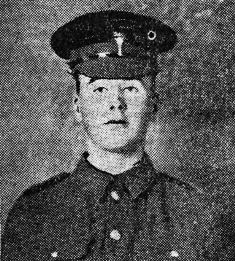
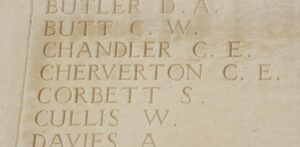
Dan Henry Davies, Private, 5985, King’s Liverpool Regiment. Dan was the son of Jonathon and Mary Davies, of Gwynfryn, Llanwenog. He was educated at Llanwenog School and at Lampeter College, before taking up a post as a teacher at the Kirkham Grammar School, Lancashire. He enlisted at Blackpool on 16 December 1915 into the 5th Battalion Kings Liverpool Regiment. The Battalion landed at Le Havre on 22 February 1915, joining 6 Brigade, 2nd Division, and in December 15 transferred to 99 Brigade, 2nd Division, before re-transferring into 165 Brigade, 55th (West Lancashire) Division. Dan landed in France to join the battalion on 5 July 1916, four days after the opening of the Somme offensive. In July the Division moved into positions facing the German front line at Guillemont, on the Somme. Dan was killed by a German shell on the Somme on 5 July 1916, aged just 23. It was his very first day in action. He was originally buried on the battlefield, but his grave was exhumed in 1920, and Dan was reburied in Péronne Road Cemetery, Maricourt, France.
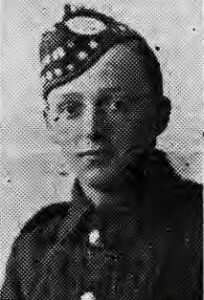
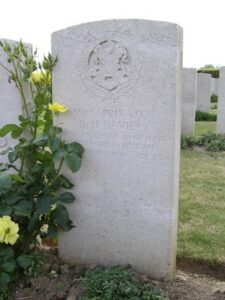
John Clarke Davies, Private, 3346, Welsh Guards. John was the son of Mary Davies, of Beilibedw, Drefach. He was educated at Llanwenog School. John enlisted at Caerphilly into the 1st Battalion, Welsh Guards, who had been in France since July 1915 attached to the 3rd Guards Brigade, Guards Division. John probably got posted to the front after the Somme battles of 1916, joining the Battalion at Ypres, where they took part in the opening assault of Third Ypres, the Battle of Pilckem Ridge. After helping to secure Pilckem, the Guards had a brief rest, before moving back into the line, and taking part in the Battle of the Menin Road, the Battle of Poelcapelle and the First Battle of Passchendaele. It was during the latter battle that John was killed, on 12 October 1917. He has no known grave, and is commemorated on the Tyne Cot Memorial, Belgium.
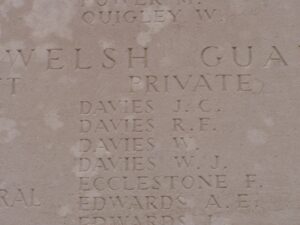
William Davies, MM, Private, 5540, Royal Welsh Fusiliers. William was the son of Thomas and Hannah Davies, of Penybont Cottage, Llanwenog. He enlisted at Tonypandy into the 2nd Battalion, Royal Welsh Fusiliers, and landed in France on 27 December 1914 to join the battalion, which was by then attached to 19 Brigade, 33rd Division, after having fought independently during the first weeks of the war. The Division saw its first major action during the Battles of the Somme, from July 1916 onwards. It then moved north, and fought at the Battles of the Scarpe. William was killed near the Hindenburg Line, during the Third Battle of the Scarpe, on 21 May 1917. He was 24 years old, and is commemorated on the Arras Memorial, France. William was the holder of the Military Medal, which he had been awarded for Bravery in the Field, probably during the Somme offensive.
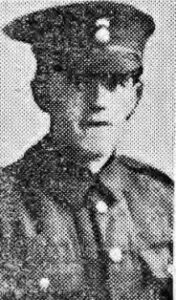
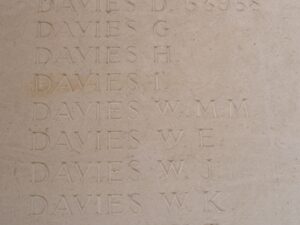
David Lewis Evans, Private, 203572, Oxfordshire and Buckinghamshire Light Infantry. David was the son of John and Elizabeth Evans, of North House, Llanybyther. He was educated at Llanwenog School while the family had resided at Rhydiau, Drefach prior to the war, and enlisted at Llanybydder into the Royal Buckinghamshire Hussars. David then transferred into the 6th Battalion, Ox and Bucks Light Infantry, which was attached to 60 Brigade, 20th (Light) Division, which had been in France since July 1915. David would have joined the battalion after the Somme Battles of 1916, when it took part in the advance to the Hindenburg Line before moving to Ypres. David was killed at The Battle of the Menin Road on 20 September 1917. He was 28 years old, and is commemorated on the Tyne Cot Memorial, Belgium.

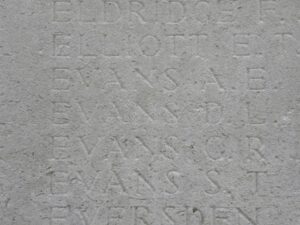
Thomas Davies Evans, Driver, 730701, Royal Field Artillery. Thomas was the son of Thomas and Sarah Evans, of Green Meadow, Llanybyther. He had married prior to the war, and lived with his wife, Gwen Evans, at Glynteg, 33, Foreland Road, Whitchurch, Cardiff. Thomas enlisted at Cardiff into the 2nd Welsh Brigade, Royal Field Artillery, which was attached to the 53rd (Welsh) Division. The Division landed at Gallipoli in August 1915, and suffered terrible casualties over the coming months, before being evacuated to Egypt in January 1916. It then took part in several skirmished in Egypt, before becoming part of the drive into Palestine in March 1917. Thomas became ill during the latter stages of the campaign, and died at Cairo on 6 November 1918. He was 32 years old, and is buried at Cairo War Memorial Cemetery, Egypt.
David Hughes, Private, 19019, South Wales Borderers. David was the husband of Dinah Hughes, of Tenby Cottage, Llanybyther. He enlisted at Ystradgynlais into the 5th Battalion, South Wales Borderers, which moved to France in July 1915 attached to 58 Brigade, 19th (Western) Division. The Division saw its first major action during the Battle of Loos on 25 September 1915. The Division moved to the Somme Sector in 1916, where they took part in the gallant capture of Ovillers-La Boiselle on 3 July 1916. David must have been wounded on the Somme, and was evacuated back via the network of Casualty Clearing Stations and Hospitals in France, before being sent to Bowood Hospital. He died there of his wounds on 16 September 1916, aged 37, and is buried at Aberduar Welsh Baptist Chapelyard, Wales. Many thanks to Bev Lewis, of Swansea for the photograph of David’s grave.

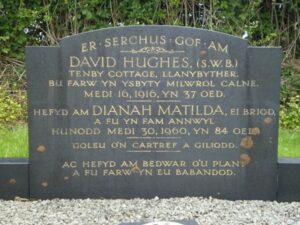
Evan Tom Jones, Private, 43634, Worcestershire Regiment. Evan was the son of David and Mary Jones, of Llettyrwenol, Cwrtnewydd, Llanybyther. He enlisted at Narberth into the Cheshire Regiment, before being posted to join the 2/8th Battalion, Worcestershire Regiment. The battalion had been in France since May 1916, attached to 183 Brigade, 61st (2nd South Midland) Division. The Division saw its first major action at Fromelles, which turned out to be a disaster, costing thousands of needless casualties. The Division didn’t see further action until the Third Battle of Ypres late in 1917, and the Battle of Cambrai later that year. The Division again suffered heavy casualties during the German Spring Offensive of 21 March 1918, fighting a gallant rearguard action near St. Quentin, before being moved to Flanders, where it again saw heavy fighting. The Division then took part in the Advance in Flanders from August 1918 onwards, and it was during this advance that Evan was killed on 5 October 1918. He was just 18 years old, and is buried at Leuze Communal Cemetery, France. There is also a memorial to Evan at Capel y Bryn, Cwrtnewydd.
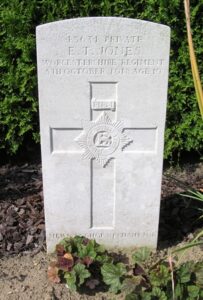
John Jones, Private, 2380109, Canadian Infantry. John was born at Drefach on 9 May 1889, probably the son of David and Hannah Jones, of Pantyronen, Drefach. He had emigrated to Canada prior to the war, where he lived with his Uncle, Tom Davies, at Durban, Manitoba, Canada, working as a Carpenter. He enlisted at Manitoba in November 1917, and was posted to France to join the 33rd Battalion (Manitoba), which was a feeder battalion to other Canadian units. John was killed in France on 2 October 1918. He was 29 years old, and is buried at Bucquoy Road Cemetery, Ficheux, France.
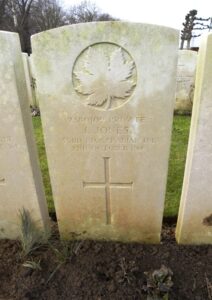
Duncan Ian Bowen Lloyd, Lieutenant, Indian Army. Duncan was born on 16 March 1886, the son of Charles and Margaret MacFie Lloyd (nee Campbell), of Waunifor, Maesycrugiau. He was educated at Oswestry Grammar School, and Clifton College before attending Sandhurst in 1905. Duncan was gazetted Second Lieutenant in 1906, and accepted a Commission into the Indian Army in 1907, seeing service in India. At the outbreak of war he was Quartermaster of the 1st Battalion, 5th Ghurkha Rifles, which had served in the Middle East before landing on Gallipoli. Duncan was placed in charge of the 1/6th Ghurkha Rifles there, but was killed in action at Damajelik Bair, during the Defence of Helles on 14 August 1915, aged 29. He was originally buried where he fell, but his grave was lost during further fighting, and today Duncan is remembered on the Helles Memorial. Duncan was mentioned in Sir Ian Hamilton’s Despatches on 17 March 1917, for his gallant services at Gallipoli.
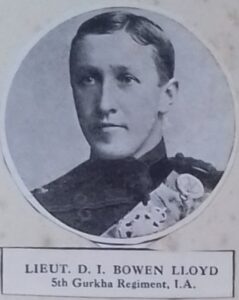
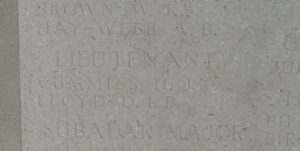
Gwion Llewellyn Bowen Lloyd, Captain, Dorsetshire Regiment. Gwion was born on 21 February 1888, the son of Charles Lloyd, and of Margaret MacFie Lloyd (nee Campbell), of Waunifor, Maesycrugiau. Gwion had been commissioned into the Dorsetshire Regiment, and served with their 5th Battalion, attached to 34 Brigade, 11th (Northern) Division. The Division came into existence of Army Order No.324, issued on 21 August 1914, authorising the formation of the six new Divisions of K1. It was formed of volunteers, under the care of the War Office. Initially without equipment or arms of any kind, the recruits were judged to be ready by late spring 1915, and it was ordered to reinforce the beleaguered garrison on Gallipoli. On 1 July 1915 the Division sailed from Liverpool, landing at Alexandria, and on to Mudros, completing concentration by 28 July 1915. On 7 August 1915 they landed at Suvla Bay, Gallipoli, and fought in the Battle of Sari Bair, where Gwion was killed in action on 11 August 1915, aged 27. He has no known grave, and is commemorated on the Helles Memorial, Gallipoli, alongside his brother Duncan.
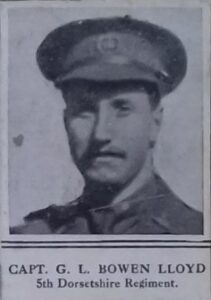
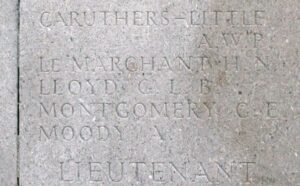
James Alexander Logan Stewart, Lieutenant, Rifle Brigade. James was born on 7 March 1893, and educated at Winchester and Trinity College, Cambridge. He was the son of Lieutenant James Logan Stewart, 7th Hussars and the Hon. Eveline Mary, of Alltrodyn, Llandyssul. James was commissioned into the Rifle Brigade on 2 September 1913, and was promoted to full Lieutenant on 30 November 1914, being sent to the front in December, 1914, where he was posted to their 1st Battalion, was attached to 11 Brigade, 4th Division. James hadn’t been on the Western Front for long, when he found himself in charge of two Platoons at Shell Trap Farm, Wieltje, during the Battle of Frezenberg. He was reported missing on 13 May 1915, and was later notified as have been killed in action that day by the Red Cross. James was only 22 years old, and is buried in Poelcapelle British Cemetery, Belgium.
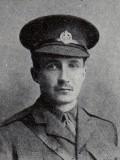
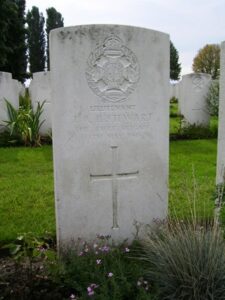
James Thomas, Sergeant, 15052, Grenadier Guards. James was the son of Evan and Hannah Thomas, of Pandy, Rhuddlan, Llanybyther. He was educated at Llanwenog School. James enlisted at London into the 2nd Battalion, Grenadier Guards. At the outbreak of war, the 2nd Battalion was in Barracks at Chelsea, and on 15 August landed in France attached to 4th (Guards) Brigade, 2nd Division, taking part in the retreat from Mons to the Marne. The Division then saw heavy fighting at Ypres, and the Battle of Festubert the following year. In August 1915 a Guards Division was created, and the 2nd Battalion, Grenadier Guards joined 1st Guards Brigade, Guards Division, taking part in the Battle of Loos the following month. In the summer of 1916 the Division moved to the Somme, and it was there, during the Battle of Flers-Courcelette, that James was wounded. He died on 16 September 1916, aged 26, and is buried at St. Pierre Cemetery, Amiens, France.
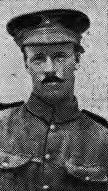
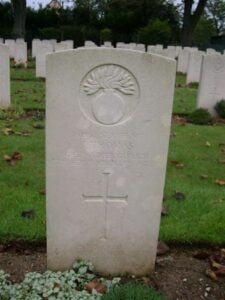
World War Two, 1939-1945
John Derrick Edwards Davies, Pilot Officer (Air Gunner), 176215, Royal Air Force Volunteer Reserve. John was the son of Daniel Edwards Davies and Katherine Davies, of Llanwenog (later of Market Harborough, Leicestershire). He served with 180 Squadron, Royal Air Force, which was equipped with the North American Mitchell II, based at RAF Dunsfold. John died on 15 June 1944, probably during an air crash. He was 21 years old, and is buried at Brookwood Military Cemetery, Surrey.
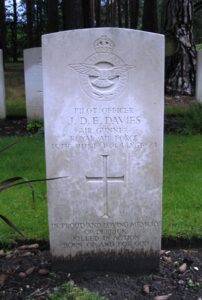
Jonathan Cecil Davies, Gunner, 14270863, Royal Artillery. Jonathan was the son of Mr. and Mrs. D. J. Davies, of Drefach. The family later resided at Craig Cefn Parc, Glamorgan. He served with 59 Medium Regiment, Royal Artillery, which landed in Normandy at the end of June 1944 attached to the 3rd Army Group, Royal Artillery, and fought alongside the 43rd (Essex) and 53rd (Welsh) Divisions during their drive through northern France into occupied Belgium and Holland. Jonathan was killed in Holland on 2 December 1944. He was 21 years old, and is commemorated on the Groesbeek Memorial, Netherlands.
James Lewis Evans, Ordinary Seaman, D/JX. 399443, Royal Navy. James was the son of William and Mary Evans, of Drefach, and the husband of Kathleen Audrey Evans, of Greenfields, Shrewsbury, Shropshire. He served with the Royal Navy at HMS Drake. Drake was an old French ship which was used for training purposes, and was moored at Fort Blockhouse. James must have been taken ill whilst serving aboard here, and died on 11 May 1943. He was 26 years old, and is buried at Llanwenog (St. Gwenog) Churchyard.
Tom Jenkin Lloyd Evans, Chief Officer, Merchant Navy. Tom was from Tangraigfach, Llanwenog. He served with the Merchant Navy aboard the SS Brinkburn, which was a Sunderland registered cargo steamer. On 21 June 1943, Brinkburn was in convoy TE-22, when she was torpedoed and sunk by the German submarine U-73 west of Algiers. Tom was amongst 27 men who died in the sinking that day. He was 33 years old, and is commemorated on the Tower Hill Memorial, London. The ship was at the time believed to have been the victim of sabotage.
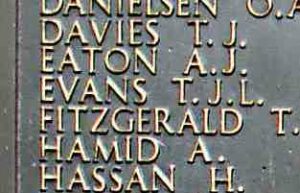
William Stanley Evans, Aircraftman 1st Class, 1303366, Royal Air Force Volunteer Reserve. William was the son of Thomas Mordecai Evans and Maggie Evans, of Llanybydder. He served with 113 Squadron, Royal Air Force, which was equipped with the Bristol Blenheim IV, based at Maaten Bagush. William was probably wounded after German Messerschmitt 110 attacked the airfield on 8 July 1941. He died on 11 July 1941, aged 19, and is buried at El Alamein War Cemetery, Egypt.
John Charles Jenkins, Pilot Officer, 64315, Royal Air Force Volunteer Reserve. John was the son of David John and Gwendolene Jenkins, of Llanwenog. He served with 214 Squadron, Royal Air Force, which was equipped with the Vickers Wellington, based at RAF Stradishall. John was killed when his aircraft, Wellington Mark II R1613 BU-G, was attacked by a German fighter whilst taking part in a raid on Bremen on 15 July 1941. The remainder of his crew bailed out of the damaged aircraft and were taken PoW. John was 20 years old, and is buried at Rheinberg War Cemetery, Germany.
Teifi Jones, Aircraftman 1st Class, 1123171, Royal Air Force Volunteer Reserve. Teifi was the son of John and Ellen Jones, of Cwmgilfachwen, Llandyssul. He served in the RAFVR, and had been captured at some time by the Japanese in the Far East, and given the POW No. 2659. Teifi was taken to Sandakan Number 2 Camp, and the British were later moved from this camp to the Number 1 Camp about 15 April 1945. Survivors were then moved back to a wired section of Number 2 Camp on 29 May 1945. Teifi is recorded as having died of Malaria while a POW, on 21 July 1945. There is evidence of a large number of POW’s murdered by the Japanese on the ‘Sandakan Death Marches’ as they were killed, and their deaths attributed by the Japanese to disease. Teifi was 23 years old, and is remembered on the Singapore Memorial.
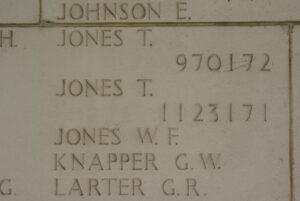
Johnny Lewis, Sergeant (Air Gunner), 1445360, Royal Air Force Volunteer Reserve. Johnny was the son of John and Elizabeth Lewis, of Henfaddau, Silian, Lampeter, and the grandson of Lewis Lewis, of Meinigwynion Mawr, Llanwenog. He served with 44 Squadron, Royal Air Force, which was equipped with the Avro Lancaster BIII, based at RAF Dunholme Lodge. Johnny was killed when his Lancaster, Serial ND751, was shot down by a German FW90 night-fighter during a raid to destroy a V1 rocket launch site in Pommeréval on 25 June 1944, and crashed, killing all of the crew. Johnny was 22 years old, and is buried at Criquetot-Sur-Longueville Churchyard, France.
Evan Leonard Pugh, Third Officer, Merchant Navy. Evan was the son of William Pugh, and of Jane Pugh, of Ciliaiu Aeron. He served with the Merchant Navy aboard the MV San Calisto, a London registered oil tanker. On 2 December 1939, San Calisto struck a mine and sank two and a half miles south-west of the Tongue lightship. Evan was among six men killed during the sinking that day. He was 27 years old, and is commemorated on the Tower Hill Memorial, London.
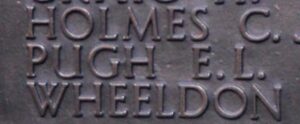
Thomas Arthur Thomas, Corporal, Home Guard. Thomas was born on 21 August 1907. He married Margaret Gwyneth Jones in 1937 and the couple initially set up home at Glanafon, Llanybydder. Thomas was a motor lorry driver prior to the war, but enlisted into the Home Guard and was posted to the Llanwenog Platoon. He died at Aberystwyth Infirmary on 25 June 1944, following an accident. The remains of the 34-year-old were brought home and he was buried in Llanwenog Cemetery four days later. By now his widow, Margaret, was residing at Tegfan, Llanwenog. Thomas is not commemorated as a casualty by the CWGC, nor is he commemorated on the Llanwenog war memorial.